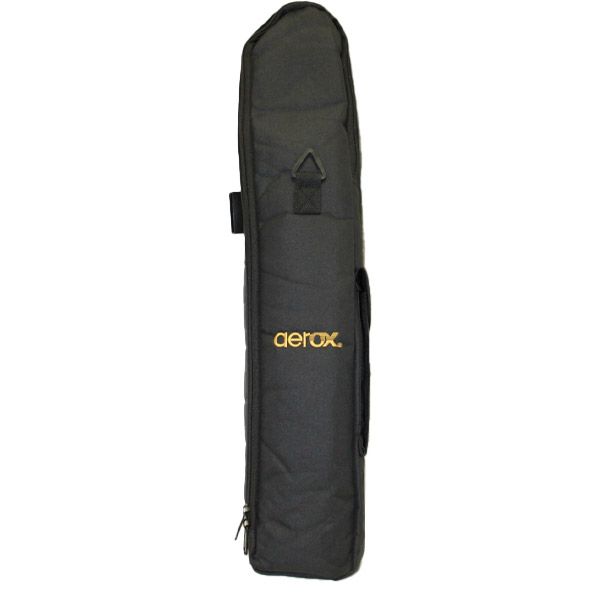Aerox Deluxe Seat Back Cylinder Carrier
Aerox Deluxe Seat Back Cylinder Carrier
Manufacturer Part Number: SBx
Aerox Deluxe Seat Back Carrying Case for Portable Systems
General Description
Aerox Deluxe Seat Back Carrying Case for Portable Systems - The Aerox Seat Back Carrier conveniently attaches your Aerox portable oxygen system to the seatback of your aircraft. Zipped construction for easy access to the bottle and a convenient pouch to store your regulator when not in use. Select your portable bottle size above.






What is Oxygen?
Composition of Oxygen. Oxygen includes 21% of the atmosphere at all altitudes. The remaining atmosphere consists of 78% nitrogen and 1% traces of other gases. Oxygen under normal conditions is an odorless, colorless, tasteless, non–combustible gas. It is the most important single element on earth. At each breath we fill our lungs with air. Millions of tiny air sacs (known as “alveoli”) in our lungs inflate like tiny balloons. In the minutely thin walls enclosing each sac are microscopic capillaries through which blood is constantly transported, from the lungs to every cell in the body. The blood carries the oxygen extracted from the air in the lungs to every part of the body. Because the body has no way to store oxygen, it leads a breath–to–breath existence. The human body must have oxygen to convert fuel (the carbohydrates, fats, and proteins in our diet) into heat, energy, and life. The conversion of body fuels into life is similar to the process of combustion; fuel and oxygen is consumed, while heat and energy is generated. This process is known as ”metabolism“. The rate of metabolism, which determines the need for and consumption of oxygen, depends on the degree of physical activity or mental stress of the individual. Not all people require the same amount of oxygen. A man walking at a brisk pace will consume about four times as much oxygen as he will while sitting quietly. Under severe exertion or stress, he could possibly be consuming eight times as much oxygen as resting.
How Important is Oxygen in Flying?
Let’s understand the importance of bringing more oxygen to the body. Blood is the liquid carrier of oxygen. Blood carries oxygen to all parts of the body to fuel its systems, stimulate its chemical reactions, and rid it of wastes and toxins. The feeling of being tired is the classic sign of oxygen–deficiency or “Hypoxia”. When we are oxygen–deficient, (which occurs at higher altitudes while flying) we are not equipped to have incomplete chemical reactions occur in our body. We don’t burn waste properly and our blood and cells become toxic. Some cells that are deficient in oxygen may mutate into colonies of disease in their battle for survival. Viruses, fungi and bacteria begin to grow. Our whole physical energy level is low and we just don’t feel right; or worse, we catch a debilitating disease. When oxygen levels are increased, our red blood cells pick up the extra oxygen and become energized. We feel better, arrive at our destination less tired and more alert for the all–important part of the flight, LANDING. Our body is healthier and we think more clearly because of increased oxygenation.
FAA and Oxygen
Oxygen Requirements at Altitude. The FAA requires that all pilots flying their aircraft above 12,500′ for 30 minutes or longer or at 14,000′ or above during the entire flight must use supplemental oxygen. The amount required is 1 liter of oxygen per minute for every 10,000′. For example, at 18,000′ there should be a flow of 1.8 liters per minute of oxygen available via a standard breathing device. The FAA requires there should be a device so attached to each breathing device that visually shows the flow of oxygen. (Aerox flow meters meet this FAA requirement.) The FAA also regulates that passengers must have supplemental oxygen available over 15,000′ and that it is recommended that supplemental oxygen be used at night at altitudes over 5,000′.
Storing Cylinders
Compressed gas containers should not be subjected to atmospheric temperatures above 130° F. A flame shall never be permitted to come in contact with any part of a compressed gas container. Containers shall not be stored near readily ignitable substances such as gasoline or waste papers, or near combustibles including oil. Containers shall not be exposed to continuous dampness nor be stored in the sun.
Why do Knowledgeable Pilots Use Oxygen Over 5000′
You can go without food for days, water for hours, but if you are denied oxygen for only a few minutes you can’t survive. Oxygen is crucial to your system. Vision is impaired as low as 5000′ especially at night (the FAA recommends oxygen at 5000′ at night). All the physical processes of your body, such as circulation, assimilation, digestion, and elimination “run” on oxygen. As a result, oxygen helps your body produce energy, balance its metabolism, purify itself of wastes, and fights fatigue. Flying tired is not fun.

























